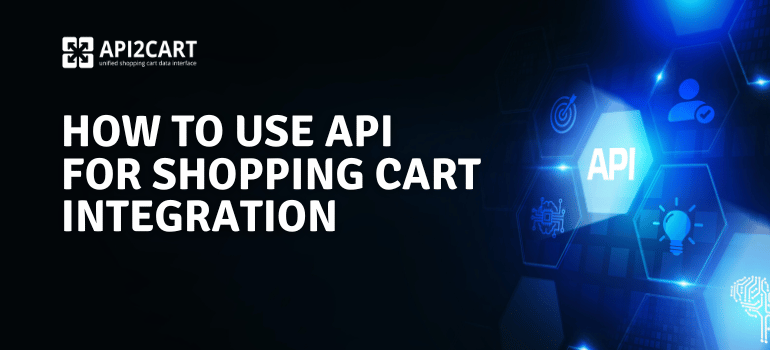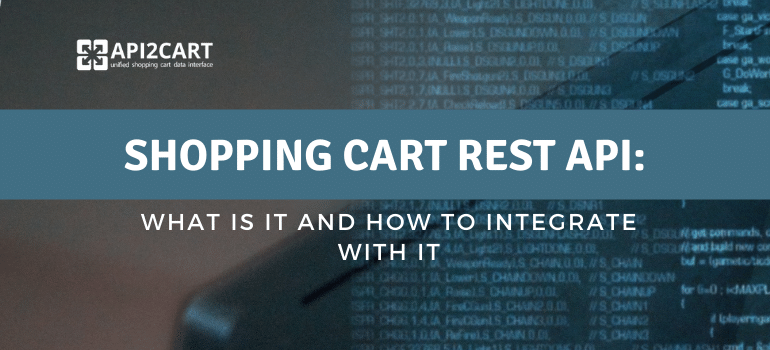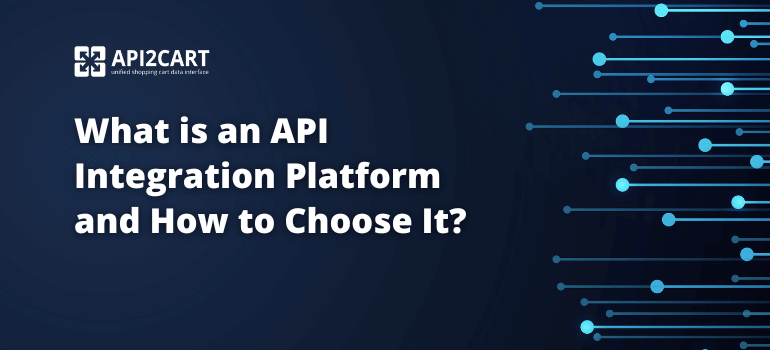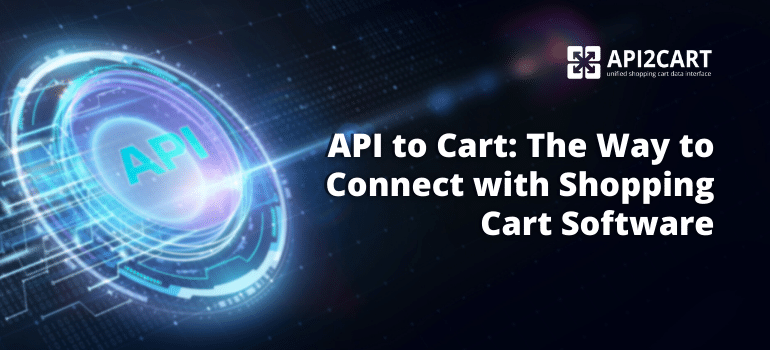
The eCommerce world has changed. It is no longer just a matter of buying and selling goods. Today, it also means helping online retailers simplify their eCommerce operations.Thanks to the development of API and integrating it, several software suppliers are now providing e-retailers with solutions for managing their operations more effectively.
Reading this article, you will have a better understanding of API to cart- the way that connects any piece of software or app with eCommerce platforms. Along with this we will talk about what an API is , how it's used and several examples of shopping cart APIs as well. We will also examine the concept of using a single unified API for shopping cart integrations.
What Does API Mean?
An API or application programming interface is a medium of communication between two applications or software products. It allows them to interact with each other and transfer data.
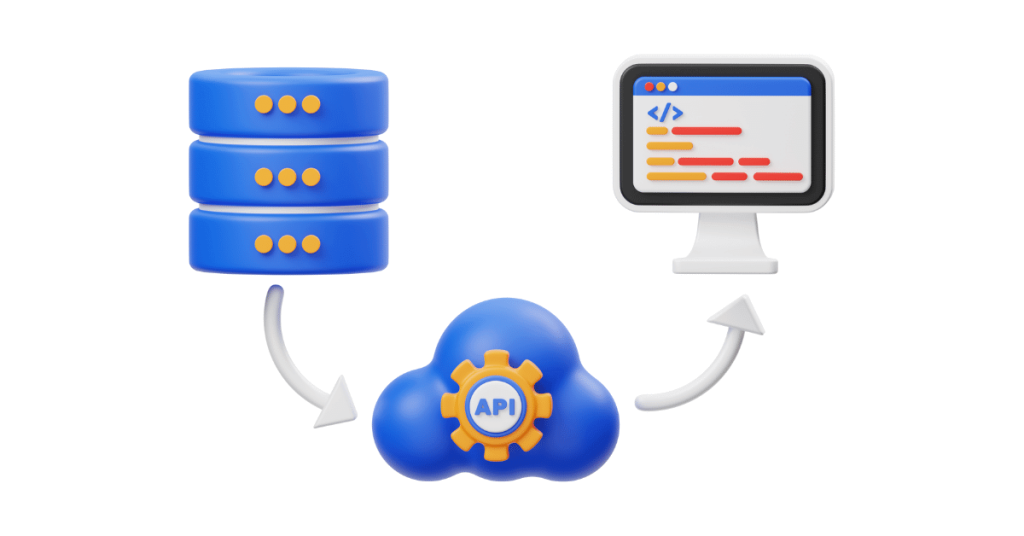
It means that when you request some information from one application for another application, it needs a middle man to convey your request to the latter application. API is that middle man who takes your request to another application and takes a response back to your application.
There are two main types of APIs: REST API and SOAP API.
REST API: REST stands for representational state transfer. It is a set of the architectural principles. The REST service must have specific characteristics that include simple interfaces, which are resources identified within the request and manipulating resources using the interface. It is a constraint-based concept that allows clients to access server data under the limit of 6 constraints and with the help of 4 methods — GET, PUT, POST, and DELETE.
SOAP API: SOAP means the simple object access protocol. It allows the clients and servers to exchange information using XML. The main function of this API is to define the exact structure of the messages and the method of communication. It also uses Web Service Definition Language in a machine-readable document that allows the publication of a definition of its interface.
What is the API of the Shopping Cart Software?
Before you understand the nuances of API to cart, let’s talk about shopping cart software and their APIs.
A shopping cart software is a SaaS solution for eCommerce businesses that allows online retailers to automate and simplify their day-to-day eCommerce tasks.
Shopping cart software can cover everything from accepting an order to managing, syncing, and updating the inventory to shipping and delivery. It reduces human intervention and allows retailers to concentrate on their core business operations.
The shopping cart API is a specific programming interface for shopping carts that allows the latter to communicate with other applications and transfer its data for several purposes. These shopping cart APIs help to connect various applications to shopping cart software. They allow the transfer of online store data between the shopping cart solution and different third-party apps and software programs.
For API to cart functionality, shopping cart API usually employs four HTTP methods:
- GET — This method collects all the required information for the requesting resource
- PUT — This method updates all the information required by the requesting resource
- POST — This method created new entries for the requesting resource
- DELETE — This method deletes resources when needed
What is Possible to Do With a Shopping Cart API?
A shopping cart API allows various software to interact with it and access the required data to perform the core eCommerce operations.
You can perform the following operations using shopping cart API:
- add all the required items to the shopping cart — use HTTP POST requests
- retrieve all the data related to products, orders, categories, and customers from the online stores of the shopping cart — use HTTP GET requests
- remove all the product, order, and customer-related data from the client stores — use HTTP DELETE requests
- update data related to all the categories mentioned above on the clients’ stores — use HTTP update requests
The Best Examples of Shopping Cart APIs
Here are some famous examples of shopping cart APIs:
- Magento API
- Shopify API
- WooCommerce API
Magento is the choice of more than 250,000 merchants across the globe. It is a reliable shopping cart software, and therefore its API allows the developers to work with online stores’ products, orders, customers, and categories. It also enables support for XML and JSON formats to access the resources and use four methods — GET, PUT, POST, and DELETE. In addition, Magento API uses both REST and SOAP protocols for resource transfer.
Shopify is preferred by more than 1 million users across the globe. That said, like Magento, Shopify API also supports both JSON and XML formats. As a result, it helps eCommerce vendors to work with products, categories, customers, and orders. The only limitation with Shopify API is its regular API updates that might trouble you if you do not update your integrations uniformly.
Being one of the largest eCommerce platforms across the globe, WooCommerce enjoys the trust of more than 2.4 million users. Because of its RESTful structure, WooCommerce API is more stable than other shopping cart APIs. You can use it to retrieve product information, filter orders, add and delete items, etc.
Which Industries Need Shopping Cart API Integration
A lot of industries rely on shopping cart API integration for their success. Below are some of them.
eCommerce Marketing Automation Software
Marketing automation software relies on integration with shopping platforms for a number of reasons: to access data about products and orders, customer contacts, coupons, etc.
In many marketing automation processes, information from e-stores is a central component. Shopping cart integration enables systems like these to send emails with new items, discounts, and special prices to online stores' customers, notify them of order statuses, track cart abandoners, and generate smart email statistics.
Multi-Channel Software
For such systems, a seamless shopping cart API connection is a necessity. It allows them to get info on products, orders, shipments, inventory levels, etc., and update the data across all sales channels.
Shipping Management Software
Shipping software depends greatly on integration with shopping carts, which allows them to get orders from various sales channels, update tracking info and order statuses, create shipping labels, and organize the data in detailed reports.
Chatbots
To build an eCommerce chatbot, it must be integrated with the business ecosystem (shopping carts, in the first place) in order to access product catalogues, data on inventory levels and tracking numbers, etc. The system needs to be able to handle orders, change stock levels, and get lists of abandoned orders. For this to happen, it must connect with dozens of different shopping cart APIs.
What are the Main Pitfalls of Shopping Cart Integration?
Different eCommerce software for online retailers is mainly driven by integration with shopping carts to deliver their functions and products. For instance, shipping software requires integration to enable retailers to import orders and update order status.
Shopping cart API integration is a completely necessary investment for every provider of eCommerce software. There is, however, little awareness among many eCommerce software providers about how much commitment it takes to develop and maintain such integration. Integration with shopping carts is likely the greatest challenge in developing different kinds of eCommerce applications. Connecting multiple systems for data exchange is brain-racking, costly, and requires tons of technical work.
Fine work will take a very long time, particularly if you wish to connect to multiple platforms. And now consider the costs. Not only those you will encounter in the production of integration but also those linked to the continued maintenance of fully prepared and ongoing integration. Updated versions of eCommerce platforms are produced now and then so that routine upgrades are imminent.
Even more unique issues are encountered by eCommerce software providers when integrating with various data sources. It includes various attributes and object versions, differing formats and standards, optimization challenges, etc.
A unified integration with API2Cart is the smartest thing you can do. The service allows you to link to the data from 40 + shopping platforms easily. The integration with multiple shopping carts through API2Cart also provides even more advantages for your eCommerce software solution and your customers.
How to Use a Unified API for Cart Integration Development
API to Cart concept can be best presented by a unified API provided by API2Cart. It is an all-in-one API integration solution allowing eCommerce vendors to integrate their software with over 40 shopping cart solutions and marketplaces. API2Cart enables you to connect with all the shopping platforms at once. There is no need to establish separate integrations.
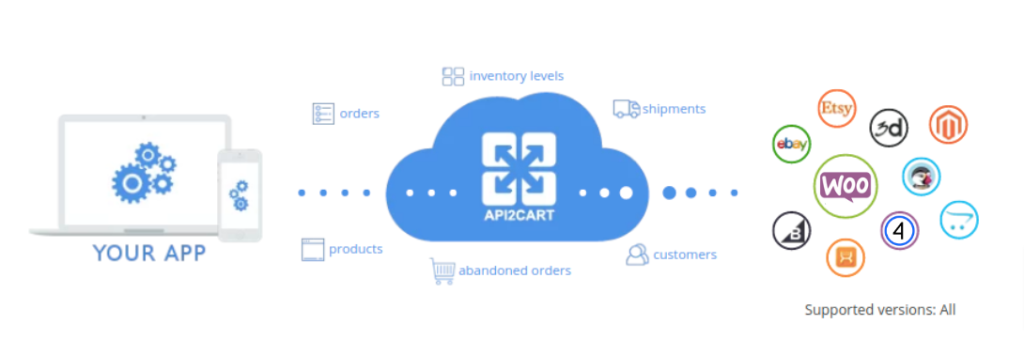
Every shopping cart API has a different logic and architecture, and API2Cart doesn’t need any developer to understand the complex structures of those APIs. Instead, it will directly integrate your software with the shopping cart systems required.
Apart from this, API2Cart also looks after the maintenance and upgrades of the integrations after every time the shopping carts updates their API. So you don’t have to bother about that too.
You have to integrate your software with API2Cart, and then it will automatically integrate it with all the shopping carts you wish to connect with. So you can remotely manage your client stores from one place with the help of API2Cart API methods.
So, if you want to know more about how API2Cart can help your business, get in touch with us today.
